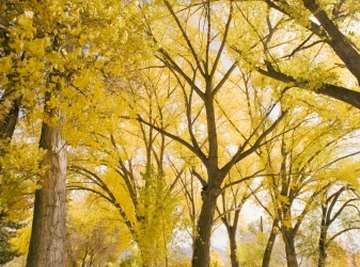
The four ecosystem types are classifications known as artificial, terrestrial, lentic and lotic. Ecosystems are parts of biomes, which are climatic systems of life and organisms. In the biome's ecosystems, there are living and nonliving environmental factors known as biotic and abiotic. Biotic factors are organisms, plants and animals, and abiotic factors are nonliving environmental factors, such as light, water or gasses in the system.
Terrestrial
Terrestrial ecosystems are land systems such as forests, deserts, grasslands, tundras and coastal regions. Depending on the biome's climate, more than one terrestrial ecosystem can be present. For example, tundras have less plant life because of lower temperatures; deserts produce fewer plants because of higher temperatures. A forest or grassland may have an extreme variety of plant life because its biome has the right amount of sunlight and moisture for many ecosystems, and species, to grow.
Lentic
Lentic is a class of aquatic ecosystems that are found on land, such as:
- ponds
- rivers
- lakes
- swamps
- streams
Mostly, lentic ecosystems are described as still bodies of fresh water, and they are smaller ecosystems. Some lentic ecosystems contain animals and microorganisms, but they mostly rely on photosynthesis of algae and underwater plants to produce energy to thrive. One of the requirements of a lentic body of water is that it is exposed to the sun to encourage photosynthesis.
Lotic
Lotic ecosystems are similar to lentic in that they are part of the aquatic water class, and the life they support is similar to that found in lentic ecosystems. The lotic systems are moving bodies of water that flow to other bodies of water and eventually to the ocean. These systems can include springs, rivers and streams, or any body of water that flows to marinelike waters or the ocean. Unlike lentic, the lotic systems do not thrive off photosynthesis and can include bodies of fresh- and saltwater, such as an estuary where fresh water mixes into saltwater flow.
Artificial
Although artificial ecosystems could be included with terrestrial, lentic and lotic, some feel it is important to environmentalism to examine man-made systems. Man-made systems include areas as large as beaches and forests, and those as small as terrariums, for example. Sometimes they are made to replenish the environment, and other times they are to help environmentalists learn. Biodomes, for examples, are closed, artificial ecosystems created for the study of biology.
About the Author
Jamie Ott began writing professionally in 2009. She is the author of young-adult novels "Maternal Absence" and "Jacko Conjurer." Ott holds an accounting degree and is pursuing a bachelor's degree in business communications and professional writing.
Photo Credits
Jupiterimages/Comstock/Getty Images
